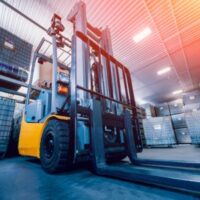Don’t Be A Victim To Forklift Mishaps

Believe it or not, seven in ten workplace accidents are completely avoidable; that’s according to the Occupational Safety and Health Administration (OSHA). The fact of the matter is that with proper training and by implementing reasonable safety procedures, businesses can avoid the lion’s share of workplace accidents that plague the nation. That being said, the truth is that construction site and warehouse workers, among others, are involved in tragedies involving forklifts all too frequently. If you’ve been the victim of a serious workplace injury due to improper training, shoddy procedures, insufficient supervision, or improperly maintained equipment, you may be entitled to damages to address the costs associated with the incident. It’s worthwhile to contact an experienced local attorney regarding the matter.
Forklift Accidents
Forklifts are such commonplace pieces of equipment that sometimes people forget that they constitute heavy machinery and are capable of serious harm. Nearly 100,000 accidents occur annually, causing injuries to operators and/or bystanders. Over 30 percent of these injuries are serious; roughly 100 people die as a result of those injuries every single year. The data are clear: forklifts are to be taken seriously. What kinds of accidents occur most often?
- Overturning: Operators and/or bystanders experience crushing injuries in more than 40 percent of forklift accidents when the machine topples over, frequently due to unbalanced loads.
- Collisions: Forklifts are very maneuverable, making them somewhat unpredictable to bystanders. About 10 percent of forklift accidents involve a forklift striking someone in the work area, while nearly one-third of injuries are a result of the forklift crushing a worker in the work zone.
- Falling loads: One in ten forklift accidents involve boxes and materials falling onto workers, causing serious injuries.
- Operator falls: In roughly five percent of accidents, forklift operators fall from their seat, or workers on platforms above the forklift fall onto the forklift itself.
What About Training?
Without question, proper training is an important mitigation strategy when it comes to these kinds of accidents. Not only is it a common sense obligation for employers to train employees: federal law requires it. In addition to restricting operation to adults aged 18+, certification requirements include training in a number of areas:
- Understanding the machine’s capacity and limitations, as well as facts related to the vehicle’s stability;
- Instruction on the safe maneuvering on ramps or slopes;
- Procedural information related to loading, stacking, and unloading materials;
- Safety protocols and checklists to ensure the machine is in good operating condition;
- Information specific to the jobsite and particular hazards there.
Following a Forklift Accident
If you’ve been seriously injured in a forklift accident, you are one of thousands across the country who discovered that these machines can be very hazardous when training and safety protocols are lacking. To discuss your situation, contact the efficient, knowledgeable Baltimore workplace accident attorneys at the Law Office of Hasson D. Barnes today.
